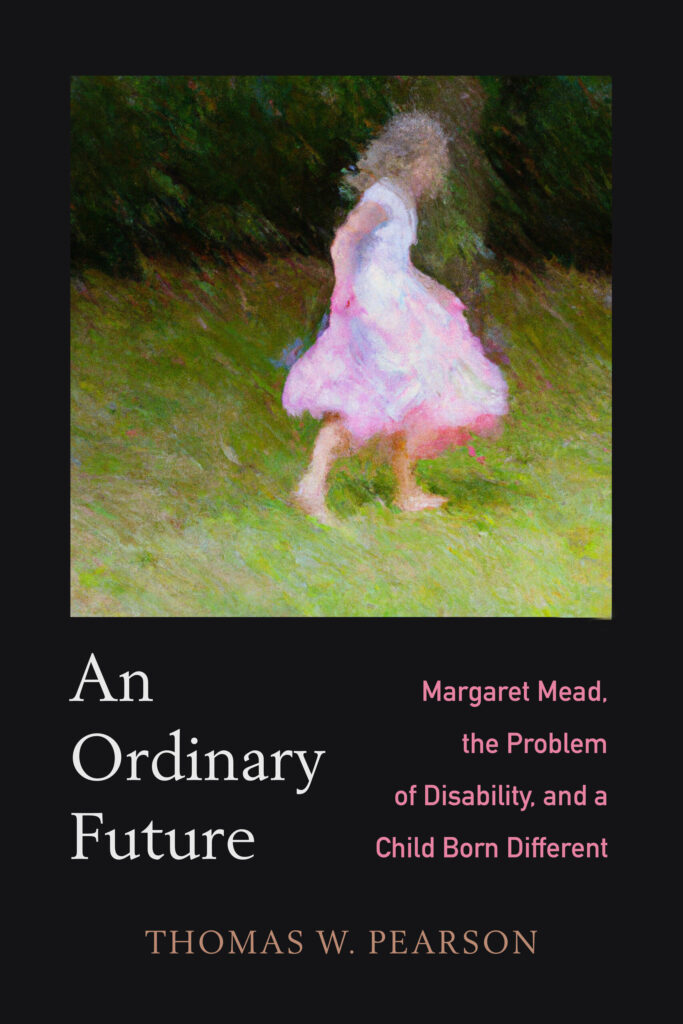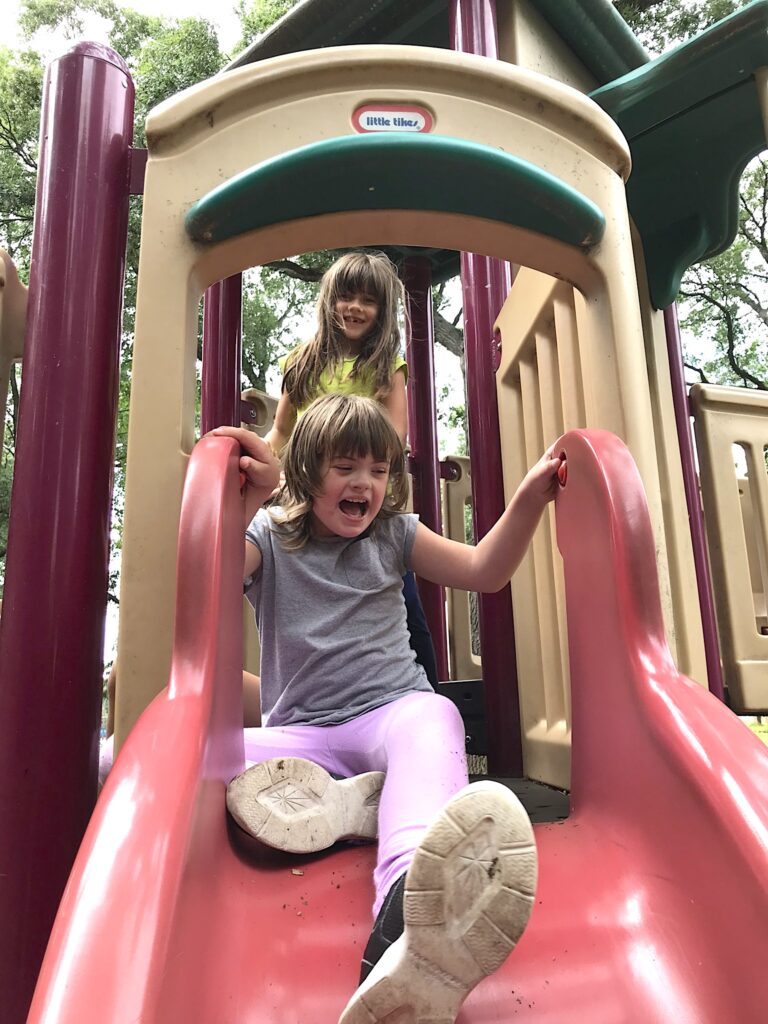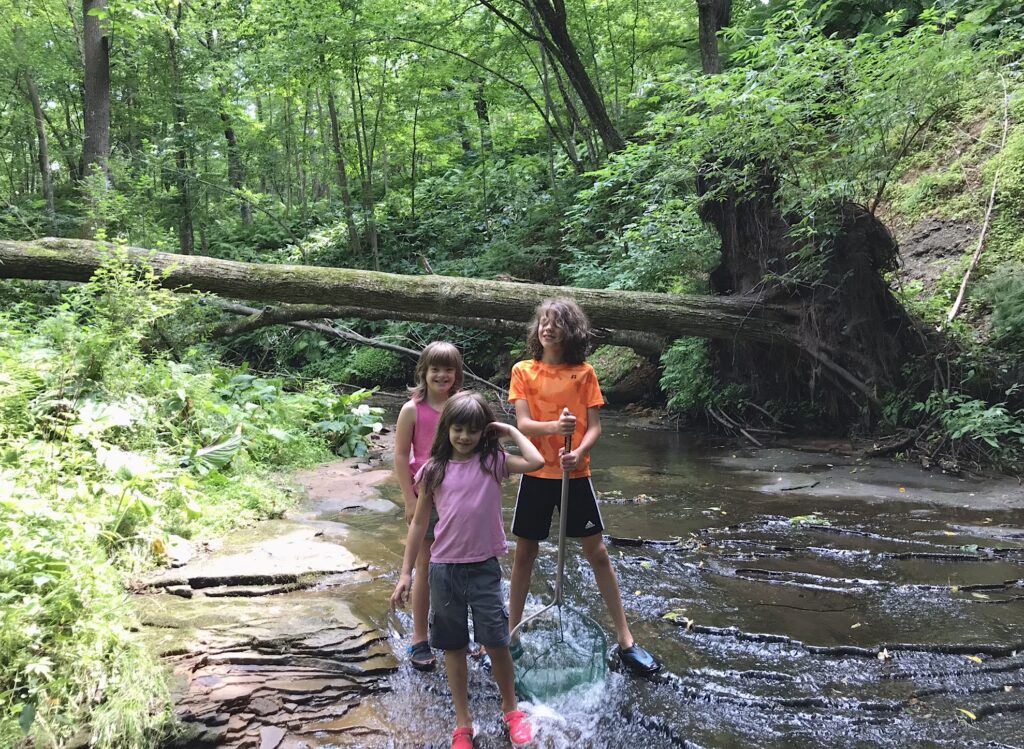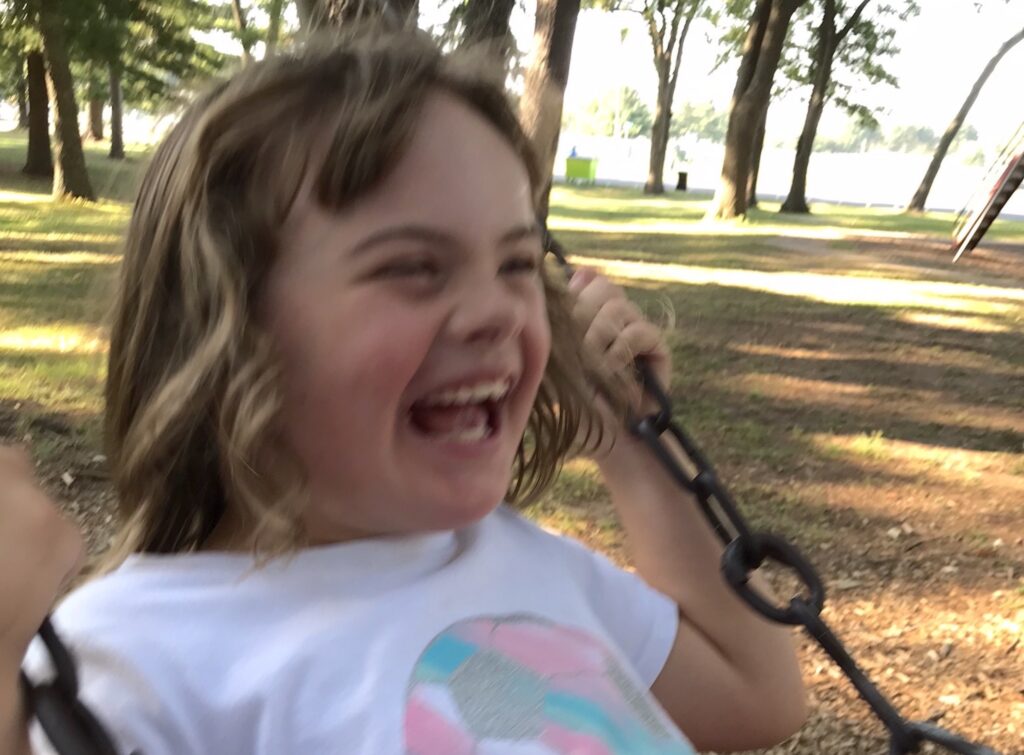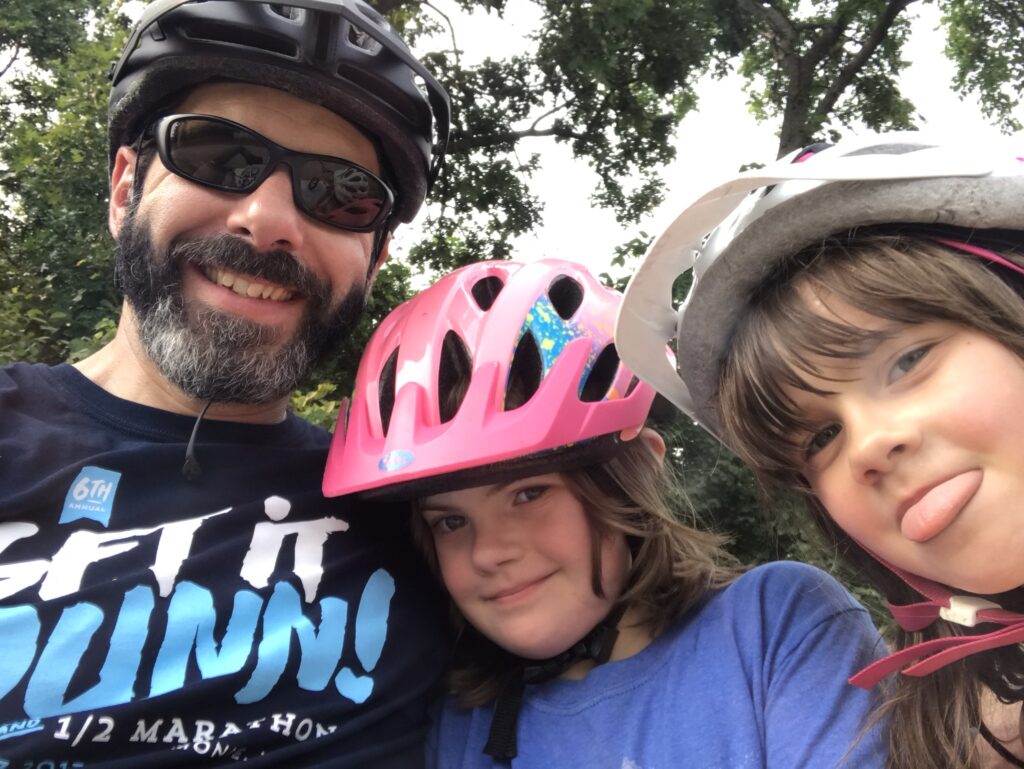Raising My Children in an Ableist World
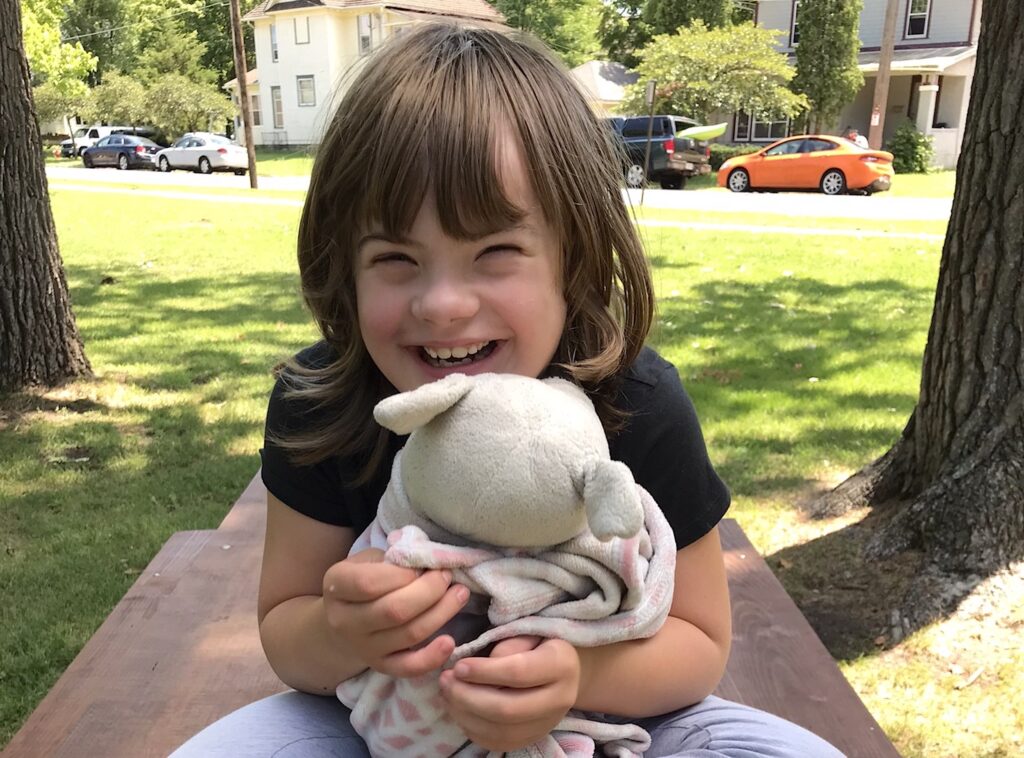
Excerpted from An Ordinary Future: Margaret Mead, the Problem of Disability, and a Child Born Different by Thomas W. Pearson. University of California Press, 2023. All rights reserved.
One summer day, I found myself at a playground with all three of my children. Aidric, the oldest, and I had ridden our bikes as usual. I had pulled his younger sisters, Michaela and Zora, in our red bike trailer, battered from years of use. Shortly after our arrival, two other children ran up to the playground. Aidric, Michaela, and Zora were climbing the pretend rock wall and tumbling down plastic slides. Aidric soon began playing with a girl about a year older than him. He introduced himself and then his siblings.
The girl had noticed Michaela. Kids about Aidric’s age appear to pause and contemplate Michaela—her sometimes halting use of language, rocky pronunciation of certain words, mannerisms that don’t strictly follow tacit social norms, perhaps the trademark physical features of Down syndrome. But I’ve found that other children are not generally put off by it. They may observe for a moment, since kids are tremendously curious about the world they inhabit, but they don’t assign special meanings to her personality or identity unless adults around them do so first. Normally, it’s the parents who seem confused, and from a place of uncertainty, their default reaction is avoidance. Children, by contrast, just take it in and then figure out how best to interact with Michaela.
I contemplated this as I stepped off to the side to allow the kids space to play together, wanting to give them some autonomy. But I couldn’t help but eavesdrop on the conversation that ensued.
“My name is Aidric,” he said. “I’m 7 years old. Almost 8. My birthday is in August. My talent is running and jumping.” I raised an eyebrow and wondered why he was suddenly listing physical abilities.
“That girl down there is Zora, my sister,” said Aidric, after he climbed to an upper level of the jungle gym. “Her talent is fighting.”
I chuckled and couldn’t help but agree. Zora is a spitfire, and it’s not unknown for her to bully Aidric, who is twice her age and twice her size. It’s usually not a violent or aggressive form of fighting, not something fueled by hostility or outright meanness. She’s just forceful when she wants to be. Daring. Tough. Adventurous. All good qualities.
“My other sister is Michaela,” continued Aidric.
I listened intently, wondering how he would describe her.
“We haven’t figured out her talent yet.”
I was awestruck, and not because he couldn’t think of something. Michaela does everything her siblings do. She runs, jumps, climbs, and rides. She has no limits at the playground. She fights with her brother and sister, and often dominates wrestling matches. Yet it is true that Michaela does not run as fast as Aidric or climb as well as Zora, who is two years younger. She tires more quickly, needs to rest more, especially on hot days. Aidric was riding a bike independently at an age when she still uses training wheels. When Zora wants to get away, Michaela struggles to catch her.
But Aidric did not focus on any of these perceived weaknesses or delays. He did not resort to listing deficiencies, to comparing her to some assumed average or norm. He simply reasoned that we haven’t figured out her talents yet. It’s not that she does not have talents. We have simply failed to identify them.
That summer, Michaela already 6 years old, I no longer viewed her as a child with Down syndrome. I’m not sure when it happened. Like many forms of change, it was a process, a combination of purposeful reflection and just being swept up in the flow of life—settling into new routines, normalizing what had once seemed unfathomable. But within the first year or two, I stopped seeing Down syndrome every time I looked at Michaela.
Read more from this author, from our archives: “A Daughter’s Disability and a Father’s Awakening.”
At their ages, too, now 8 and 4 years old, Aidric and Zora do not view Michaela through the lens of disability. We periodically talk to them about Down syndrome and let them know they can always ask questions, preparing them with vocabulary and conceptual tools to navigate life as siblings of a sister with Down syndrome. But it’s not something Aidric ever asks about. Zora is still too young for those sorts of conversations, though we’ve started mentioning to her that sometimes Michaela needs a little more guidance. But in our day-to-day family life, Michaela is not a child with Down syndrome. She is a sibling, a daughter, a friend. She is Michaela.
These moments of stunning openness and acceptance punctuate the daily drama of parenting, filled with frustrating flashes of kids fighting, pushing boundaries, and refusing to cooperate. It’s both amazing and overwhelming. As Alison Piepmeier writes, describing her own experience as a mother of a daughter with Down syndrome, parenting in general is difficult, “not the specifics of parenting a child with Down syndrome.”
During the same summer as that park visit, Zora had an abscessed front tooth extracted. Still woozy from the procedure as we returned home, she proudly marched in the house with three bouncy balls, her prize from the dentist’s office for being a cooperative patient. She had insisted on getting one each for Aidric and Michaela. I ushered them and their projectiles outside and grabbed my shoes, sitting on the porch to put them on. I watched all three kids bounce the balls higher and higher off the driveway. Before long, Aidric bounced one over the house and into the backyard. They all ran after it. I went through the house and came out the back to help them find the ball in the long grass and weeds.
As we looked around, I realized Michaela wasn’t with us. I dashed back into the house and into the garage, and finally into the driveway. I spotted her down the block on a bicycle, heading toward an intersection that marks the edge of our neighborhood. The cross street doesn’t usually have heavy traffic, but with no stop signs, the periodic car sometimes drives at high speed. Michaela only occasionally looks for cars and often has her head down when she rides a bike. All my kids are prohibited from crossing that street on their own, and one of my missions in life is to teach them to religiously stop at the intersection and look carefully for cars.
In an ableist world, a child with disabilities is “watched” and stared at in ways that other children are not.
I sprinted down the street to catch up with Michaela. She was riding a dark-red, pedal-less balance bike, on which she is impressively fast, and wearing a white toy astronaut helmet, with the tinted visor pulled down. As I ran at full speed, she turned into the last house’s driveway before the intersection and then rode into the grass, zigzagging between a row of tall pine trees with skinny trunks. I slowed down, relieved she wasn’t headed into potential danger.
“Michaela, what are you doing?” I asked, catching my breath as I strolled toward her.
“I’m looking for Zach! Where’s Zach?”
“Who is Zach?” I asked.
“Aidric is Zach,” she responded, slightly annoyed, as if I should have known already.
“Oh, are you pretending to be the Wild Kratts?” I asked.
The Wild Kratts is a popular PBS Kids show, featuring the real-life Kratt brothers, Martin and Chris, who teach viewers about wild animals, then narrate an animated adventure with cartoon versions of themselves competing with a rotation of villains, one of whom is named Zach Varmitech, a whiny, irritable genius who tries to dominate nature with technology. Michaela likes to pretend to be Aviva Corcovado, the bold engineer who accompanies the Kratt brothers on their adventures and invents all their creature power suits, which allow them to take on the special powers of certain animals to battle with villains such as Zach.
“Yes! Aidric is Zach!”
Interesting, I thought. Whatever might this say about her perception of her older brother?
I convinced her that Aidric/Zach was still at home, and she agreed to ride back. We had been bouncing balls, Michaela had been playing Wild Kratts.
What is called “elopement” by professionals has been something of a minor challenge with Michaela in recent years. Sometimes the behavior is referred to as “bolting.” But she doesn’t take off randomly, as if she has no idea what she’s doing, so that’s not an accurate term. Rather, she gets an idea in her head, just wants to go for a bike ride or explore something, and then acts on the impulse.
One time, she ran down a bowling alley lane straight for the triangle assortment of pins at the end. Another time, when I was waiting with her during Aidric’s soccer practice at an elementary school gymnasium, she removed her clothes and ran down a hallway lined with other parents. They looked up and watched. I suddenly felt embarrassed by the sting of public shame, objectified by their gazes as Michaela transgressed behavioral norms, and I rushed to restore her “proper” public behavior by chasing after her.
I have come to realize that my experience of shame reflects the ableist attitudes and practices that police our behavior in social settings. Ableism describes assumptions and attitudes that reinforce notions of normality and devalue those who fall outside its parameters. As disability studies scholar Fiona Kumari Campbell writes, we live in a world where we constantly learn “that to be disabled is to be less than, a world where disability may be tolerated but in the final instance, is inherently negative.”
In such a world, a child with disabilities is “watched” and stared at in ways that other children are not. From the reproachful glance to the hard, judgmental stare, parents of children with disabilities, and disabled persons themselves, frequently confront the scrutiny of others who unwittingly and silently seek to enforce ableist norms. The stare itself sends the message: You are out of line. After our family attended a party at a friend’s house, for instance, a colleague felt compelled to tell me how surprised they were that Michaela seemed like such a “normal” child compared to the other kids present. I had no idea they were so closely watching her.
Elopement is one of those transgressive behaviors that can reveal unspoken ableist norms, the world of taken-for-granted cultural expectations made obvious by my own embarrassed reactions or those of others watching. While sometimes elopement is impulsive, other times it is calculated, a way to get attention, with Michaela relishing the excitement of me chasing her down a school hallway or down the street as she approaches the intersection. I unintentionally reinforce the behavior with my frenzied reactions; it makes it exciting, so she does it more. Sometimes I have no choice but to give chase for safety reasons, but if I just ignored her, such elopement would likely diminish. This behavior has been improving as she gets older and I learn to cope with the ableist gaze of others, but it’s still annoying.
It’s especially frustrating when Zora does it. As a fiercely independent 4-year-old, she feels entitled to leave on her bike like her older brother, and she takes joy in defying me.
As Michaela and I walked back to the house, Zora suddenly appeared in the front yard wearing nothing but her underwear. Earlier in the day, she had taken her clothes off and sat under the kitchen table drawing lines over much of her legs and arms with a black pen. Now her clothes were off again. Holding Michaela’s hand, I looked up to see Zora scurry through the yard and into the street. As she ran away, I also noticed she had peed a little, leaving a wet spot on her backside. Some of our neighbors, a retired couple who walk their cat around the neighborhood, watched silently as she ran past them into the street—little wet butt, inked-up body, and missing front tooth. She screeched joyfully as I chased after her. I was not laughing. The cat stared at us from the curb.
This from my neurotypical 4-year-old. Hilarious in retrospect, exasperating in the moment.





























